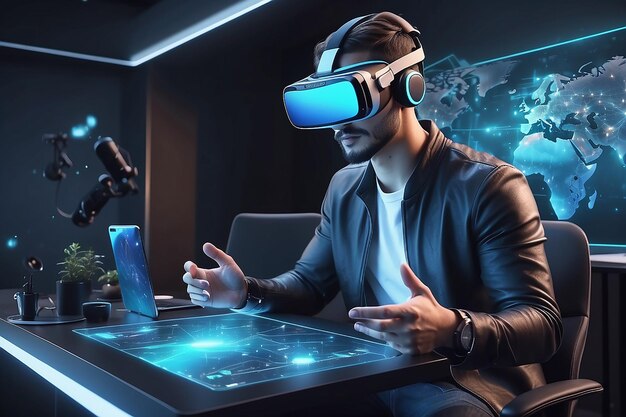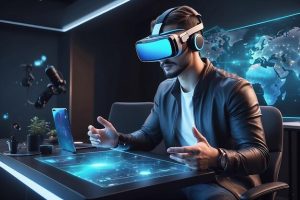
Virtual Reality and Augmented Reality: How They Are Changing Our World

Technology is moving faster than ever, and two exciting innovations leading the way are Virtual Reality (VR) and Augmented Reality (AR). You have probably heard about them or even experienced them through games, apps, or videos. But VR and AR are more than just cool tech they are transforming how we live, learn, work, and even shop.
In this article, we’ll explore what VR and AR actually are, how they’re different, where they are being used today, and what the future might look like with these technologies all around us.
What Is Virtual Reality (VR)
Virtual Reality is a technology that creates a computer-generated world. When you wear a VR headset, like the Oculus Quest or PlayStation VR, it feels like you’ve stepped into another environment. Everything you see and hear is made by a computer whether it is a game, a simulation, or a 3D video. You can look around, move, and interact with objects as if you are really there.
For example, you could be sitting on your sofa, but in VR, you are climbing a mountain, swimming underwater, or exploring a different planet. Using VR, the real world disappears and you are in a new virtual environment.
What Is Augmented Reality (AR)
AR brings virtual objects into your real surroundings. It does not take you away from your surroundings instead, it adds virtual objects or information on top of what you see. You might have used AR without even realising it.
One popular example is Pokemon Go, where you can see game characters appear in your real environment through your phone screen. Other examples include filters on Instagram or Snap chat that change your face or add fun animations. AR is also used in apps that let you see how a sofa would look in your room before you buy it.
Key Differences Between VR and AR:Virtual Reality and Augmented Reality
Let’s break it down simply:
Feature Virtual Reality (VR) Augmented Reality (AR)
Experience Fully virtual Real world with digital additions
Devices Used VR headsets Smartphones, tablets, AR glasses
Environment Completely digital Real world with overlays
Examples VR games, training simulators Pokemon Go, Snap chat filters
In short:Virtual Reality and Augmented Reality
VR = You leave the real world.
AR lets you see the real world along with added virtual elements.
Where Are VR and AR Being Used Today
Although VR and AR started in the world of gaming and entertainment, they are now being used in many fields and the list keeps growing.
Education and Learning:Virtual Reality and Augmented Reality
VR allows students to take virtual field trips to museums, ancient cities, or space — all from the classroom. AR helps bring books to life by adding 3D visuals or animated content. Both technologies make learning more fun and easier to understand.
Healthcare and Medicine:Virtual Reality and Augmented Reality
Virtual Reality and Augmented Reality: Doctors use VR to practice surgeries without risk. AR helps during real operations by showing vital information right on the patient. These tools also help train medical students more effectively.
Shopping and Retail
AR is changing how we shop online. Many clothing and makeup brands now let you try products virtually before you buy them. Furniture apps let you place virtual items in your home using your phone camera to see if they fit and match.
Real Estate
VR home tours let people look around houses or apartments without going there physically. It saves time and helps buyers view multiple properties using their phones or VR headsets.
Remote Work and Business
Virtual Reality and Augmented Reality: Many businesses now use VR to hold meetings and train workers. Instead of normal video calls, people can join a virtual office, talk with coworkers, and give presentations all within a digital space.
Entertainment and Games
Gaming was one of the first areas where VR and AR became popular. It feels like you are truly inside the game when using VR. AR, on the other hand, adds fun elements like characters and puzzles right into your real surroundings.
What is the Future of VR and AR
Virtual Reality and Augmented Reality: The future looks exciting. As devices become smaller, faster, and cheaper, more people will use VR and AR in their everyday lives. Tech giants like Apple, Meta (Facebook), Google, and Microsoft are already investing billions into developing next-generation VR and AR devices.
Soon, we might see:
Lightweight AR glasses that show notifications or directions in front of your eyes
VR being used for mental health therapy and stress relief
AR in cars, helping drivers with real-time directions and safety warnings
Virtual classrooms where students from different countries study together
These are not far-off dreams many of these things are already being tested and rolled out.
Why Should You Care About VR and AR
Whether you are a student, a professional, or just someone who loves trying new things, VR and AR are tools that can make life easier, more efficient, and more enjoyable. They are not just for tech experts. As the technology becomes more user-friendly, it will become a regular part of everyday life just like smartphones did.Virtual Reality and Augmented Reality
Learning how VR and AR work and staying updated can help you get ahead in school, career, or business. It may even open up new opportunities for work or creativity.
Final Thoughts:Virtual Reality and Augmented Reality
Virtual Reality and Augmented Reality are not just popular terms — they are real technologies already making a difference in the world. Whether it is helping doctors perform better, making learning more interactive, or just making games more fun, VR and AR are becoming part of our everyday lives.
As more people and businesses adopt these tools, they will become even more powerful and widespread. So if you have not tried VR or AR yet, it’s a good time to explore what they offer. We are already living in the future, and it’s more engaging than ever.
